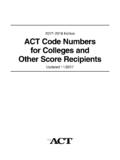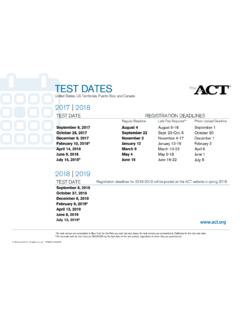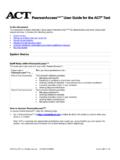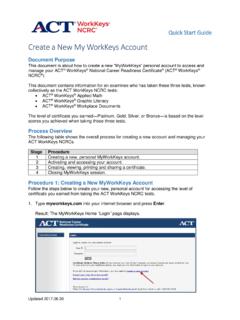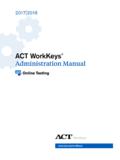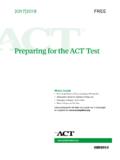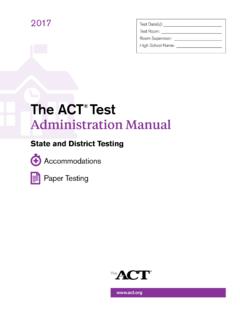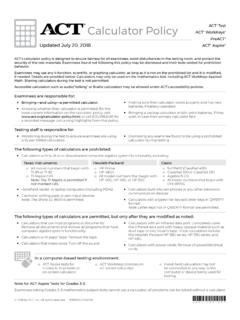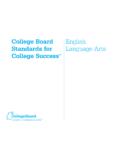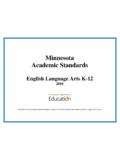Transcription of The ACT Test
1 2017l 2018. the act Test . User Handbook for Educators What's Inside Overview of the act . Preparing for and Taking the act . ACT Reports and Services Uses of ACT Data What's New for 2017 2018. ELA Benchmark (page 43). English Learner Supports (page 19). Extended Time Testing Policy Change (page 21). July Test Date (page 17). Fifth Test on National Test Dates (page 2). Updated Sample Score Reports (pages 40 41, 53 54, and 59 60). Updated Terms and Conditions (pages 33 36). ACT endorses the Code of Fair Testing Practices in Education and the Code of Professional Responsibilities in Educational Measurement, which guide the conduct of those involved in educational testing. ACT is committed to ensuring that each of its testing programs upholds the guidelines in each Code.
2 You may locate copies of these Codes through the following organizations: Code of Fair Testing Practices in Education: American Psychological Association ( ). Code of Professional Responsibilities in Educational Measurement: National Council on Measurement in Education ( ). 2017 by ACT, Inc. All rights reserved. ACT National Curriculum Survey and ACT Online Prep are trademarks, and ACT , ACT Aspire , ACT ASSET , ACT Compass , ACT Explore , ACT Information Manager , ACT National Curriculum Survey , and ACT Plan are registered trademarks of ACT, Inc. Contents Contents What's New for 2017 2018 i 1 Overview of the act Test 1. Components of the act Test 1. Test Scores 1. Multiple-Choice tests 1. Optional Writing Test 2.
3 Fifth Test 2. Reporting Categories, Other Scores, and Readiness Indicators 3. Measurement Error and Score Ranges 4. College and Career Readiness Standards 4. ACT College Readiness Benchmarks 5. ACT National Curriculum Survey 5. US and State Ranks 6. Additional Information about the tests of Educational Development 6. Noncognitive Components 7. High School Course/Grade Information 7. Accuracy of High School Course/Grade Information 7. ACT Interest Inventory 8. Development and Content 8. Scores 10. Interest-Major Fit 10. Career Map 11. Career Connector 12. Student Profile Section 13. Composite Scores from Multiple Sets of ACT Scores 14. What Are Postsecondary Institutions Using as an ACT Composite Score for Students Who Have Multiple Sets of Test Scores?
4 14. Why Would Postsecondary Institutions Prefer One Approach Over Another? 14. Which Approach Does ACT Recommend? 14. 2 Preparing for and Taking the act 16. Preparation Options 16. ACT Aspire 16. Test Preparation Materials 16. Registering for the act 17. Choosing a Test Date 18. ii Contents Choosing a Test Option 18. Testing for Students with Disabilities 19. Services for Examinees with Disabilities 19. English Learner Supports Overview 19. English Learner Supports 19. Requesting Accommodations and/or Supports 19. Benefits of using TAA 20. Special Circumstances 21. Arranged Testing 21. Residual Testing 22. Student Web Services 23. National Registration Flyer 23. International Testing 23. Register by Mail 23.
5 Registration Deadlines 23. Standby Testing 23. College Report Recipients 24. Prebilled Vouchers 24. ACT Fee Waivers 24. Eligibility Requirements 24. Waiver/Deferral of College Admission Application Fee 25. Test Information Release (TIR) 26. Test Day Requirements 26. Admission Ticket Policy 26. Retaking the act 27. Retest Restriction 27. 3 ACT Reports and Services 28. Confidentiality of ACT Data 28. Reporting of Scores 28. Reporting to Students Online 28. Reporting to High Schools and Colleges 29. One Test Date per Report 29. Misdirected Reports 30. Automatic Reporting of Scores 30. Additional Score Reports (ASRs) 30. ASR Services Available 30. Ordering ASRs 30. Making Changes in Reports 31. Retention of Student Records 31.
6 Score Verification Service 31. iii Contents Correction of Errors 32. ACT Score Inquiries 32. Student Report 39. Complimentary Webinars Understand and Maximize ACT Report Information 39. Content Covered by the Mathematics Test 45. Content Covered by the Science Test 47. Content Covered by the English Test 47. Content Covered by the Reading Test 48. Writing Skills Measured by the Writing Test 49. High School Reporting 50. High School Score Label 50. High School Report Checklist 51. Reporting Options 52. High School Profile Service 52. High School Report 52. College Reporting 57. Reporting Options 57. ACT Research Services 57. Class Profile Service 57. Admissions Service 57. Retention/Attrition Service 58. Course Placement Service 58.
7 College Report 58. 4 Uses of ACT Data 63. Confidentiality 63. High School Uses of ACT Data 63. Discussing ACT Results in Educational and Career Counseling 63. Career Planning 64. College Planning 64. Using ACT College Readiness Benchmark Scores in College Planning 65. Information About Colleges 66. College Uses of ACT Data 68. Dissemination of Data to Campus Offices 68. Scores of Older Students 68. the act Educational Opportunity Service (EOS) 68. How EOS Works 69. Other ACT Data Services 69. Enrollment Information Service (EIS) 69. ACT Information Manager (AIM) 69. Recruitment and Admissions 70. iv Contents Predictive Modeling Indexes 70. Simplifying the Admissions Process 70. The Admission Decision 71. Course Placement 71.
8 English Course Placement 73. Placement in Other Courses 73. Academic Advising 73. Interest-Major Fit 74. US and Institutional Ranks 75. Predictive Data 76. Overall GPA and Specific Course Grades 76. 5 References 77. 6 ACT National Test Dates 81. Tables Table 1. ACT College Readiness Benchmarks 5. Table 2. Income Eligibility Guidelines 25. Table 3. ACT Cutoff Score Guide for Placement in First-Year College Courses 72. Figures Figure 1. the act Interest Inventory scales 9. Figure 2. Basic work tasks 12. Figure 4. Sample ACT Student Report 40. Figure 3. Student Report detailed results 45. Figure 5. Sample ACT high school score label 51. Figure 6. Sample ACT High School Report Checklist 52. Figure 7. Sample ACT High School Report 53.
9 Figure 8. Sample ACT College Report 59. Figure 9. College Fit High School Report 67. Figure 10. Chances of Success report 76. v CHAPTER 1. Overview of the act Test Each year, millions of high school students use ACT programs and services to develop postsecondary educational and career plans. The number of students continues to increase, and educators need to know what the test does and how the results can be used to help their students. This handbook is designed to help educators at high schools and colleges, and professionals at the district and state level, as they administer ACT testing, advise students, and use ACT data to make informed decisions. Components of the act Test the act test is made up of four curriculum-based, multiple-choice tests in English, mathematics, reading, and science, and an optional 40-minute writing test that measures essay composition skills.
10 the act tests are based on the major areas of high school and post secondary instructional programs. A student's performance on the tests has a direct relationship to his or her educational achievement. The meaning of that performance, as indicated by test scores, reporting categories, and skill statements based on the act College and Career Readiness Standards, can be readily understood and interpreted by educators and students. Test Scores Multiple-Choice tests For each of the four multiple-choice tests , the raw score is the number of correct responses. Raw scores are converted to scale scores through equating procedures to ensure that scores reported across test forms have a constant meaning (that is, a scale score of 21 on Form A has the same meaning as a scale score of 21 on Form B).
